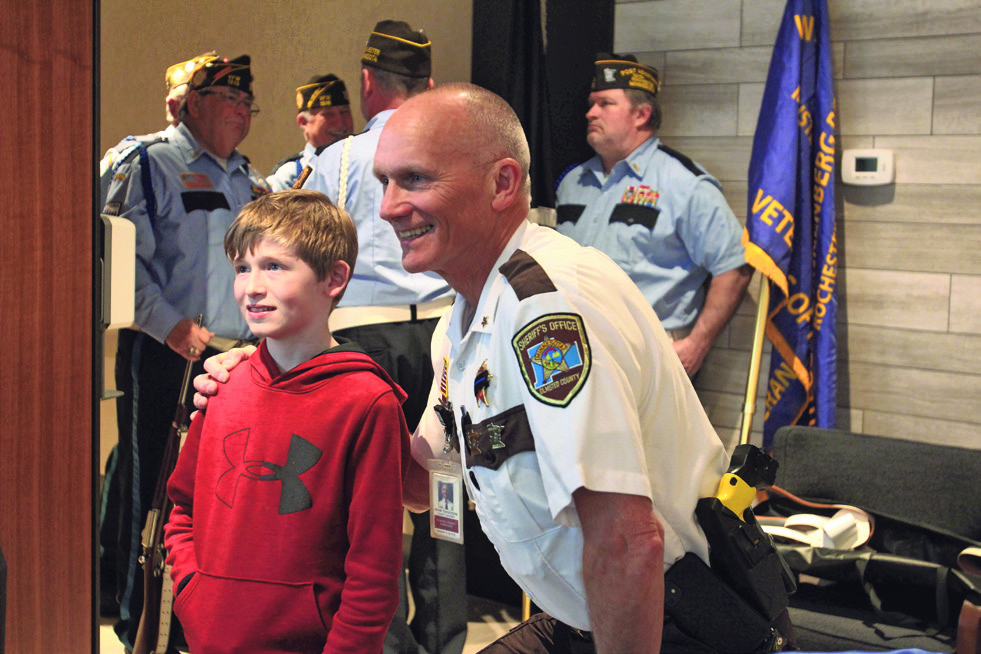
State Sen. Carla Nelson and attendees recite the Pledge of Allegiance during an open house for the Veterans and Emergency Services Exhibit on Thursday, on the ground floor of the Hilton in downtown Rochester.


ROCHESTER — There’s a history that easily spills out of Richard Krom: the development of the Veterans and Emergency Services exhibit.
But it’s for the remembrance, honor and thanks for those who serve and have served in the military and as police officers, firefighters, deputies and emergency medical technicians.
While visiting the exhibit during an open house on Thursday, Carson Warner worked the room with his smile and a thank you for all the heroes. Together with his family, including Darlene Aske and Allyson Gizzi, Warner made a list of people to thank, including Olmsted County Sheriff Kevin Torgerson and veterans.
“There’s lots of people to thank, that’s why we came,” Aske said.
The exhibit, tucked into 625 square feet on the first floor of the Hilton Hotel in downtown Rochester, is a “postage stamp” of the people’s stories the board hopes to share one day in a larger museum, Krom said. He serves as the president of the museum’s board of directors, where he volunteers alongside leaders who are dedicated to the museum’s mission of honor and education.
The exhibit opened in October 2020, though a formal ribbon cutting and open house came on Thursday.
“We made it a point that every one of our displays was based on someone here from the community, who lived in this community and who in some manner was in the military or in emergency services,” Krom said.
Richard and his late wife Sharon researched the information and designed the exhibit’s display cases.
The board has worked to share people’s stories for over a decade, which started with the work of Tom Hosier. The displays include the Rochester Police Department, the Rochester Fire Department, emergency medical services, the “warrior from the sky” Fred Hargesheimer and Staff Sergeant Reckless who served during the Korean War. A slideshow on the Korean War also runs in the middle of the display cases — when the technology cooperates.
“It’s nice to be able to go and read those stories,” said Eldon Anderson of the Korean War Veterans Club. He served in Korea near the demilitarized zone between North Korea and South Korea after the years of the Korean War. “It’s more than just a museum that shows things, there’s the story that goes along with it, and that to me is part of our … living history.”
In a moment of pause, visitors are invited to sit with the people, their stories and history.
“To educate first and foremost because our young people … they don’t know anything about any of this. They don’t know we ever were in a Korean War, they don’t even know about World War II. They don’t know anything.
We’re not teaching anything of our history,” Krom said. “Above and beyond that, we’re not building an interest in young people that assures us of having the capacity of calling on them when we may need them in the future.”
Dr. Chris Arendt, director of the Eyota Volunteer Ambulance Service, said people can help others in a lot of ways and the way he chooses is to serve as an EMT. He’s worked with the Ambulance Service for 28 years.
“I have that defibrillator,” Arendt said while pointing to a defibrillator in the display case. “Our very first defibrillator for Eyota Ambulance, our very first, was one of these battery boxes.
Unbelievable. I had even forgotten about it. How fun is that.”
While learning about Hargesheimer’s pharmaceutical connections, pointing out the big kit for rubber gloves and wondering at the trustworthiness of an old needle on display, Arendt said the exhibit is “top shelf.”
“People in EMS, especially within the medical side of it, it’s more of a humble thing,” Arendt said. “You’re there to serve, you’re not there to take the limelight. You’re there when people are in their worst. So it’s not a time to joyously jump up and down and parade about it. It’s a moment to take care of their needs.”
The displays will rotate periodically, including a hopeful addition on the Olmsted County Sheriff ’s Office. Torgerson said he is grateful for the exhibit telling an important story and history.
“We want people to be aware of those folks that put their life on the line for not just our country — firemen get killed on the job,” Krom said.
“I hope … (people) realize these were normal people who set aside their normal life to go and do these things and then they still try to have a normal life after they’ve done some of these things. Like police officers when they’re done with duty for the day, they’ve got to come home and be a husband or a father and try to be a normal person after that,” Anderson said.
While Krom sometimes loses track of people’s names that he meets in the hotel lobby, the stories of those who risked their lives continue to live in him.
He shares their stories in visits to the exhibit, at veterans meetings and through Civil War presentations. It’s history he doesn’t want forgotten.
“There’s millions of stories out there. Some of them good, some Live of them bad, some of them are just stupid, but nonetheless they are experiences of people,” Krom said. “(People) perk up their ears quickly when they’re hearing a story about a real person. And it’s one of the ways you can capture their attention, too.”
“We’re losing people who have stories that should be told,” Krom said.

